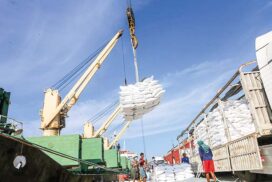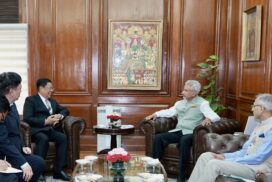Fresh and dried tea leaves from the eastern and northern Shan State are being delivered to both domestic and foreign trade partners. The value-added dried tea bricks will be manufactured for exports.
Shwepheeoo tea leaves are harvested before the pre-monsoon season (from the end of February to April). The remaining tea leaf varieties are also plucked every year. Shan State is the premier tea town in Myanmar. Kokang dried tea leaves from northern Shan State, and instant tea bricks are also popular among consumers. Green tea and black tea produced in Shan State have influenced the domestic market, and efforts are being undertaken for them to penetrate the European market.
Northern Shan State produces fresh and dried tea leaf, while the southern state primarily focuses on dried tea leaf production. The perennial tea plants from the eastern and northern Shan State have earned a reputation for dried tea leaf quality. The dried tea leaf from east Shan State is yearly shipped to Thailand. There are over a hundred thousand tea leaf acres in Shan State, and the northern area is the leading producer.
“Myanmar’s tea leaves are commonly sent to China. Efforts to penetrate the European market are underway. The Ministry of Commerce conducts an awareness project to provide technical assistance for growing methods and harvest technology. The tea leaf bricks are produced with the fragrance of flowers. The more growers reach advanced technology, the more easily they can penetrate the external market. The tea leaf is exported to foreign markets through Pyay and Mandalay cities. The dried tea leaf is worth only US$1,000 per tonne, whereas the value-added products can fetch up to $5,000 per tonne. This being so, it can generate more revenues and increase export income”, said Saw Win Kyaw, director of Myanmar Trade Promotion Organization (Taunggyi, Shan State) under the Ministry of Commerce.
Myanmar exported $480,000 worth of over 226 tonnes of dried tea leaf via maritime trade and $1.49 million valued over 4,710 tonnes via cross-border posts between 1 October 2020 and 30 September 2021, totalling 1.908 million worth of 4,936.746 tonnes. Myanmar shipped approximately 4,500 tonnes of dried tea leaf in the 2018-2019 financial year, 2,800 tonnes in the 2019-2020 FY and over 4,900 in the 2020-2021 FY, respectively. The export growth was remarkably seen in the last FY.
Myanmar will boost its production technology to place its dried tea leaf products in the European market. The country exports them yearly to Australia, Denmark, Canada, China, India, the Netherlands, Norway, New Zealand, Malaysia and Singapore. At present, Germany is eyeing Shan State’s dried tea leaf. The value-added tea bricks produced from perennial tea plants in the eastern and northern Shan State are yearly shipped to the external market.— Nyein Thu(MNA)/GNLM
Value-added tea leaf products from northern, eastern Shan State conveyed to external market
- April 05, 2022
- 1344














